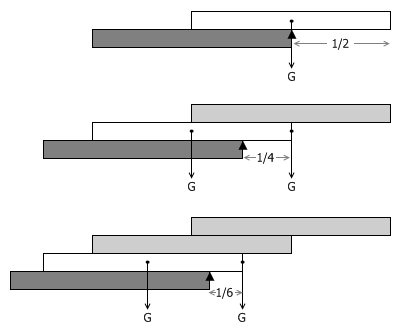杭电 HDU ACM 1330 Deck
来源:互联网 发布:mac rar解压软件 编辑:程序博客网 时间:2024/06/11 19:38
Deck
Time Limit: 2000/1000 MS (Java/Others) Memory Limit: 65536/32768 K (Java/Others)Total Submission(s): 1299 Accepted Submission(s): 749
Problem Description
A single playing card can be placed on a table, carefully, so that the short edges of the card are parallel to the table's edge, and half the length of the card hangs over the edge of the table. If the card hung any further out, with its center of gravity off the table, it would fall off the table and flutter to the floor. The same reasoning applies if the card were placed on another card, rather than on a table.
Two playing cards can be arranged, carefully, with short edges parallel to table edges, to extend 3/4 of a card length beyond the edge of the table. The top card hangs half a card length past the edge of the bottom card. The bottom card hangs with only 1/4 of its length past the table's edge. The center of gravity of the two cards combined lies just over the edge of the table.
Three playing cards can be arranged, with short edges parallel to table edges, and each card touching at most one other card, to extend 11/12 of a card length beyond the edge of the table. The top two cards extend 3/4 of a card length beyond the edge of the bottom card, and the bottom card extends only 1/6 over the table's edge; the center of gravity of the three cards lines over the edges of the table.
If you keep stacking cards so that the edges are aligned and every card has at most one card above it and one below it, how far out can 4 cards extend over the table's edge? Or 52 cards? Or 1000 cards? Or 99999?
Two playing cards can be arranged, carefully, with short edges parallel to table edges, to extend 3/4 of a card length beyond the edge of the table. The top card hangs half a card length past the edge of the bottom card. The bottom card hangs with only 1/4 of its length past the table's edge. The center of gravity of the two cards combined lies just over the edge of the table.
Three playing cards can be arranged, with short edges parallel to table edges, and each card touching at most one other card, to extend 11/12 of a card length beyond the edge of the table. The top two cards extend 3/4 of a card length beyond the edge of the bottom card, and the bottom card extends only 1/6 over the table's edge; the center of gravity of the three cards lines over the edges of the table.
If you keep stacking cards so that the edges are aligned and every card has at most one card above it and one below it, how far out can 4 cards extend over the table's edge? Or 52 cards? Or 1000 cards? Or 99999?
Input
Input contains several nonnegative integers, one to a line. No integer exceeds 99999.
Output
The standard output will contain, on successful completion of the program, a heading:
# Cards Overhang
(that's two spaces between the words) and, following, a line for each input integer giving the length of the longest overhang achievable with the given number of cards, measured in cardlengths, and rounded to the nearest thousandth. The length must be expressed with at least one digit before the decimal point and exactly three digits after it. The number of cards is right-justified in column 5, and the decimal points for the lengths lie in column 12.
# Cards Overhang
(that's two spaces between the words) and, following, a line for each input integer giving the length of the longest overhang achievable with the given number of cards, measured in cardlengths, and rounded to the nearest thousandth. The length must be expressed with at least one digit before the decimal point and exactly three digits after it. The number of cards is right-justified in column 5, and the decimal points for the lengths lie in column 12.
Sample Input
1 2 3 4 30
Sample Output
The line of digits is intended to guide you in proper output alignment, and is not part of the output that your solution should produce. 12345678901234567# Cards Overhang 1 0.500 2 0.750 3 0.917 4 1.042 30 1.997
Source
South Central USA 1998
这个题就是个物理题 ,没啥思路,搜了搜物理解决原理:如果高中物理背景不好 ,下面的话也理解不了。

这是一个非常经典的问题。传统的答案是,把第一块木板的重心放在第二块木板的右边缘,把这两块木板的重心放在第三块木板的右边缘,把这三块 木板的重心放在第四块木板的右边缘⋯⋯利用杠杆原理可以推出,如果每块木板都是单位长,那么 n 块木板可以伸出桌面 (1 + 1/2 + 1/3 + … + 1/n) / 2 个单位的长度。由调和级数的性质,我们立即可以得知,只要木板数量足够多,木块伸出桌面的长度是没有上界的,想伸出去多长就能伸出去多长。但同时,这个增 长速度也非常缓慢⋯⋯ 20 块木板只能伸出大约 1.79887 个单位的长度, 1000 块木板也只能伸出大约 4.8938 个单位的长度。
AC CODE:
#include<iostream>using namespace std;int main(){int n ;double i;int flag=1;while(cin>>n){double sum=0;for(i=1;i<=n;i++)sum+=1/i;sum/=2;if(flag){cout<<"# Cards Overhang"<<endl;flag=0;}printf("%5d %.3lf\n",n,sum);}return 0;}
0 0
- 杭电 HDU ACM 1330 Deck
- 杭电---deck
- HDU 1330 Deck
- hdu 1330 Deck
- HDU 1330 Deck
- HDU 1330Deck
- hdu 1330 Deck
- hdu 杭电acm 1002
- 杭电ACM HDU 1004
- 杭电ACM HDU 1002
- 杭电ACM HDU 1008
- 杭电ACM HDU 1013
- 杭电ACM HDU 1014
- 杭电 acm Saving HDU
- 杭电 HDU ACM 圆桌会议
- 杭电 HDU ACM Milk
- 杭电ACM--HDU-1061
- 杭电ACM--HDU-1425
- thinkpython 练习题4.3
- hdu3642 Get The Treasury
- Oracle结构化查询语言(Structured Query Language)
- Web framework之Mybatis3
- golang udp
- 杭电 HDU ACM 1330 Deck
- 10
- Hiberate之数据对象关联关系
- ORACLE_基础九(Tables)
- 【学习笔记】Navigation
- 数据定义语言(DDL)
- 8
- poj 3881 区间交判断
- 闭包专题 -- 简单易懂


